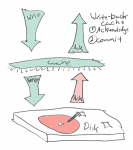Storage arrays are big, expensive, and difficult to manage. Plus, concentrating storage in a single device puts everything at risk if there is an outage. So why buy a storage array at all? Arrays do a few things very well, and this often makes up for the difference, on balance.
Symmetrix
VMware PSP and SATP in Plain English
I am often questioned during my Storage for Virtual Environments seminar presentations about VMware’s Pluggable Storage Architecture (PSA). This system is fairly straightforward and concept: VMware provides native multipathing support for a variety of storage arrays, and allows third parties to substitute their own plug-ins at various points in the stack. But the profusion of acronyms and third-party options makes it difficult for end-users to figure out what is going on.
VMware VAAI Storage Array Support in Plain English
The most exciting enhancements in VMware vSphere 4.1 is the addition of vStorage API for Array Integration (VAAI). This new API allows VMware ESX to offload storage processing functions to capable storage arrays, reducing the workload on the server hardware in introducing new and exciting possibilities for performance and efficiency. VAAI in ESX 4.1 includes three separate capabilities: block zeroing, full copy, and hardware assisted locking.
Back From the Pile: Interesting Links, December 24, 2010
Happy end-of-the-year week! I’ll be posting an 11-part series on thin provisioning starting today, but last week was eventful as well. I introduced my enterprise IT events calendar and wrote more about HP’s expiring ink and my HP printer’s demise. It was also time to write about The Four Stages of Vendor Blogging and advising my clients to Always Punch Above Their Weight.
The Four Horsemen of Storage System Performance: Never Enough Cache
Perhaps the previous discussion of spindles left you exhausted, imagining a spindly-legged centipede of a storage system, trying and failing to run on stilts. The Rule of Spindles would be the end of the story were it not for the second horseman: Cache. He stands in front of the spindles, quickly dispatching requests using solid state memory rather than spinning disks. Cache also acts as a buffer, allowing writes to queue up without forcing the requesters to wait in line.


